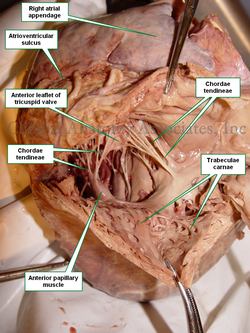|
The chordae tendineae, as their Latin name suggests, are tendinous cords found in the right and left ventricles of the heart. These chordae tendineae connect the papillary muscles to the leaflets of the atrioventricular (AV) valves. The vernacular term for these structures is "heart strings".
The function of the chordae tendineae is to limit the freedom of motion of the cusps of the AV valves (tricuspid and mitral), limiting their capacity to "flap" back into the corresponding atrium. Rupture of one or more chordae can cause retrograde flow (reflux or regurgitation) of blood from the ventricle into the atrium, causing cardiac dysfunction.
The chordae tendineae are part of a larger complex of interacting anatomical structures that include the fibrous "skeleton of the heart", the fibrous core of the AV valves, the chordae tendineae, the papillary muscles, and the complex fibrous internal structure of the papillary muscles and the ventricular wall.
The image shows the dissection of a human heart, with the right atrium open. The fan-like shape of the many chordae tendineae is clearly visible, spanning two leaflets. Observe that some chordae tendineae arise directly from the interventricular septum. These are known as the "septal chordae tendineae". Observe the atrioventricular sulcus, and the cardiac apex.
Image property of:CAA.Inc.
|
Heart - Interior of the right ventricle. Click on the image for a larger version.
|



